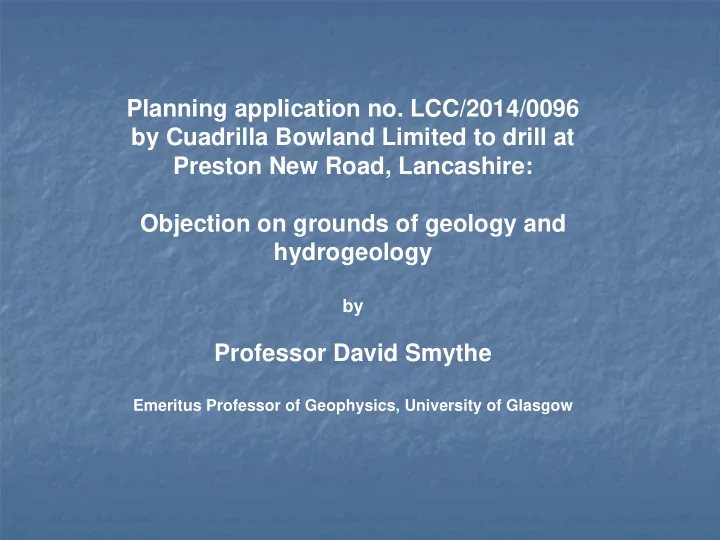

Planning application no. LCC/2014/0096 by Cuadrilla Bowland Limited to drill at Preston New Road, Lancashire: Objection on grounds of geology and hydrogeology by Professor David Smythe Emeritus Professor of Geophysics, University of Glasgow
Introduction Shale is a very common kind of rock (UK not special) Shale basins of the UK very different from USA Royal Society etc. : - fracking environmentally safe if ‘well regulated’.
Geology sections concentrated on: • Induced seismicity • Fracture growth by fracking Hardly a mention of pre-existing faults as conduits
Relied on a US industry (Halliburton) study: • Ten thousand fracked wells in the USA collated • None of the fracks penetrate upwards anywhere near the local aquifers • So pollution of groundwater by fracking not a problem - in the USA
a crucial problem in Europe Faulting:
USA and UK at same scale Pennsylvania Oklahoma England Texas Details in later slide
Shale basin sizes: UK: 5-50 times thicker than US, but 10-100 times smaller in area Northern England Bowland Basin Weald ( ) USA
Faulting and fracked wells Marcellus Shale, Bradford County, NE Pennsylvania Geology shown in UK basins colour, dots are wells have 500 times more faults than US Faults in the Fylde average and Bowland Fells at same scale Preston New Road
German study 2012 Groundwater layer Target horizon Problem of pre- existing faults as conduits
France: groundwater circulation to over 3 km depth Source: Faults are University of proven conduits Montpellier
Faults are proven conduits Bath-Bristol area: groundwater circulation to over 2 km depth (British Geological Survey)
Bowland Fells Bilsborrow Fault Coastline t l u a F R. Wyre d l o f s d o o W SSG covered by younger rocks Sherwood Sandstone Group (SSG) at surface The Sherwood Sandstone Group (SSG) at the surface: the the most important groundwater aquifer in the north of England. West of the Woodsfold Fault and south of the Wyre the SSG is covered by younger rocks, and the aquifer is highly saline.
Bilsborrow Fault Woodsfold Fault Recharge Recharge Fresh Dissolution Saline Bowland Fells to Fylde: Groundwater movement across faults (Environment Agency) Faults are proven conduits
Perspective view looking north G Bilsborrow Fault Woodsfold Fault Bilsborrow and Woodsford Faults diverge southwards from Garstang (G). Since the former fault is transmissive, it is highly unlikely that the latter is EA cross-section a sealing fault, especially in the blue-ringed zone Sherwood Sandstone at surface in West Cumbria: where sandstone is United Utilities drills water wells into geological juxtaposed against faults “ to give the best access to the yields ”. sandstone.
Preston: Groundwater movement across faults (Environment Agency 2006) Flow through faults Aquifer Faults are proven conduits
Progressive Preston New Road decrease of 3D quality • Cuadrilla - potential upward fluid migration will be “ prevented by management ” during fracking. • Well to be drilled through a fault - interpretation is unlikely and unconvincing. • Seismic data on which this sketch is based have not been released. • All layers above fracked shale, except the thin Manchester Marls, are very permeable. • Many potential migration pathways exist.
Preston New Road 4 3 B 1 A 2 Fracked shale Fault-1 Cuadrilla's Fault-1 is geologically improbable; therefore it is reinterpreted on the right at point A (monoclinal flexure made into a fault) and at B (continuation of the fault up to the sub-Permian unconformity at the base of the Collyhurst Sandstone). Fluid flow paths: 1. Directly upwards from the Upper Bowland Shale into the permeable Millstone Grit Group. 2. Up the transmissive fracture zone of Fault-1. 3. Along the highly permeable Collyhurst Sandstone, generally up-dip to the east, and only partially confined by the Manchester Marls. 4. Directly upwards from all the preceding sources through the Permian and superficial deposits to the surface.
Extension of Cuadrilla cross-section to south-east SE Preston New Road NW Permian and younger rocks t l u a F Woodsfold Carboniferous Thistleton Fault 11 km Two main varieties of fault: • Pre-Permian - only cut the Carboniferous • Faults which cut all rocks up to the surface
The 3D seismic survey: Location of the 2011 tremors Fault identification
Cuadrilla 2011: faults at Preese Hall-1 on 2-D seismic image Bottom of wellbore deviated to east Wellbore probably Faults deviated to avoid faults
3D survey coverage incomplete and inadequate Quality 0% at outer edge Preston New Road 100% limit
Cuadrilla 2014: The ‘tremor’ fault near the bottom of Preese Hall-1 Cuadrilla interpretation Modified fault interpretation Preese Preese Hall-1 Hall-1 1000 m vertical Earthquake hypocentre Oblique view of horizontal plane
Scaled cross-section through Preese Hall-1 wellbore East TVD ss depth (m) West 2400 Wellbore Better fault 2500 interpretation Deformed bore 2600 Cuadrilla fault Stage 2 interpretation Stage 1 2700 2800 2900 500 m 2930 m depth Hypocentre 3000 Preese Hall-1 did penetrate the ‘tremor’ fault • matches the 3D seismic image better • explains the well pipe deformation • accounts for why tremors started just after stage 2 fracking
Lessons from Preese Hall-1 and the 3D survey • 3D survey not up to scratch • Faults very hard to recognise in shale • PH-1 went through ‘tremor’ fault • Poor understanding of faults
Conclusions • US shale experience is no guide to UK • Faulting important in Bowland Basin - Faults often act as conduits for fluids • Cuadrilla PH-1 drilled a fault in 2011 - (just like Balcombe, Sussex) • 3D seismic survey mediocre quality • Cuadrilla fault interpretation unreliable - (just like Balcombe, Sussex) • EA self-contradictory, over-optimistic • Rocks above shales poor fluid barrier • More earthquake triggering likely Applying the precautionary principle to the risk of contamination by fluids and methane - the application should be refused
Recommend
More recommend